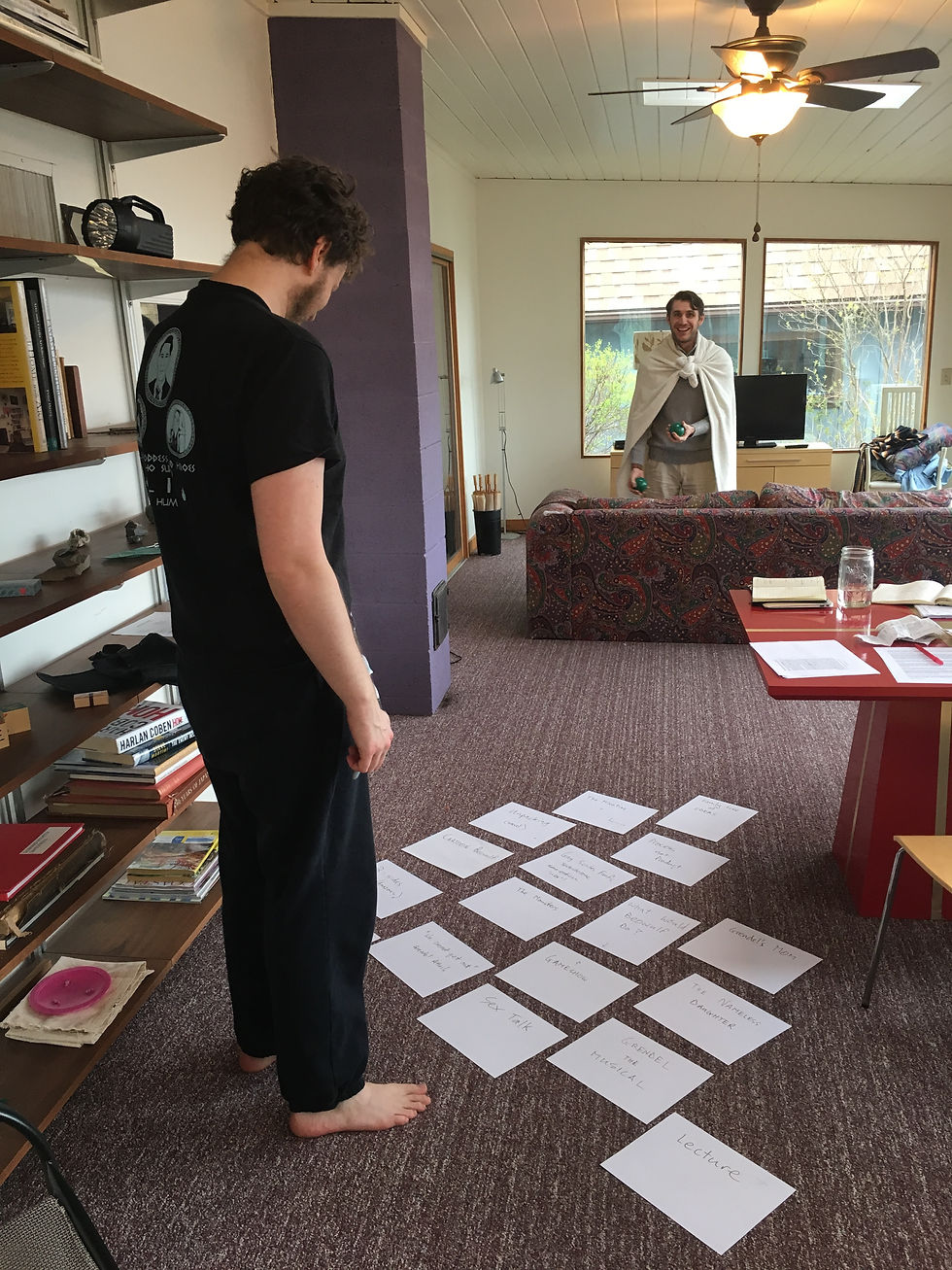Beowulf Residency at the CATWALK Institute
- Ben Morris

- Apr 23, 2019
- 4 min read
Updated: May 26, 2020

I’m spending April 2019 up in the Catskills Mountains at the CATWALK Institute working on a theatrical adaptation of Beowulf. My collaborators are a diverse group of actors, musicians, and designers, with talented director Kim Kerfoot at the helm. The facilities—a small house in a patch of woods overlooking the Hudson River about two hours north of New York City—provide the perfect inspiration and backdrop for artistic inspiration and collaboration.
Residencies are difficult. This is my second one (after a three-week stint at the Kimmel Harding Nelson Center for the Arts in Nebraska City, Nebraska this past September). The big question is, how do we divide our time? How do we maintain productivity, but also relax? And what will we have to show for it at the end… a finished product? Just ideas and fragments? How much of what we create during this residency will end up in the final piece? These are central artistic questions that we often don’t address in our lives in academia and the work world, when we are often so busy we don’t have time to even think about how we’re balancing our time. Often residencies can get lonely, and it’s hard to get started. My first week in Nebraska, I didn’t get anything done; I just reflected on my work and got to know the fellow artists-in-residence at the center.

This situation at CATWALK is unique; we’re basically a rotating theatre troupe that collectively generates the piece. At most, we’re at five people at the institute at once. It’s a blessing and a curse. We bounce ideas off each other and think of things none of us could have thought on our own. Creative ideas evolve like the branches of a tree, and certainly, loneliness is less of a thing. Some nights tend to get like a sleepover camp, with bonfires, movies, marshmallows and chips, and good conversations. It’s great fun, but we’re definitely less productive when goofing off.

Kim and I held down the fort while our collaborators came and went—we were joined by actors Quinn Rol, Philip Estrera, and Ollie Corchado, and designer Lily Prentice. Everyone brought a totally different background to our workshops. Phil and Quinn are both actors, but Phil is also a violinist, and Quinn is a budding lyricist. Lily is a talented illustrator and visual artist, contributing charcoal drawings and balloon puppets. I contributed mostly as a pianist, music director, and composer, but I also suggested story elements given my background in film and theatre. Before coming up to the Catskills, we made a few videos and set up an IndieGogo to help fund the project—this helped us get on track and come into the residency with some ideas about what we wanted to say with the project.

Our text is Beowulf—a challenge to start with. It’s a staple in English syllabi in high schools, and a “classic.” The text is weighty and bloated, with some truly epic moments but a lot of filler and historical sidetracks. This makes it difficult to parse out what is ultimately a rather simple plot—a monster Grendel haunts a mead hall. Beowulf comes and kills the monster and its mother, who seeks revenge. Later in life, Beowulf dies fighting a dragon. Despite the simple plot, there have been a dozen or so movie and theatrical adaptations, and countless English translations of the text. Kim chose Seamus Heany’s version as our main text, supplemented by commentary and scholarly critique of the text, including J.R.R. Tolkien’s famous 1939 essay about the poem. Our idea was to have the narrative go in parallel along with our contemporary anachronistic interpretations on the material, sort of like a theatrical gloss.

We began by thinking in general terms—what is the overall structure? What are we trying to say? Our initial bare-bones idea was to feature a central wooden crate that can serve multiple functions. It would be surrounded by a network of portable speakers that could diffuse music and sound FX. That would allow the piece to work in multiple venues. Our second idea was to include a meta-storytelling component, featuring a fictional theatre troupe with its own internal conflicts and differences that attempts to tell Beowulf in multiple ways. The group is led by a narrator who tries to get the group back on track to tell the central story but is constantly sidetracked by the ramblings and disparate ideas of the group.
We began writing our general ideas down on cards and spreading them out on the floor—this amassed into an ocean of paper that we have to traverse every time we need to walk across the room. That made us face the work and think of new ideas whenever we walked over the papers. The ideas branched off of one and other, and we took preexisting material and added our own personal twist to it. The ideas ran from a fake gameshow “Hunting with Hrunting” to the nameless daughter mentioned in the poem, to humorous imaginations of scribes writing the poem and troubadours and bards performing it in different eras.

Unexpectedly, we ended up writing five musical-theatre-esque “songs” about a variety of vignettes from the play, with Quinn writing lyrics. Phil played violin, and we composed and improvised medieval chants, elegiac mournful melodies, and folk tunes. The music we wrote was tactile, immediate, and dramatic—we wanted it to have a theatrical quality but be simple and catchy enough to be performed within a storytelling context. These supplemented tableau scenes and improvised monologues. We hope the piece will evolve and become a play with music, with songs and scenes flowing in and out of each other, with snippets of the original text. Our structure is very loose right now, but we have enough raw material to begin sculpting something into a great performance!



Comments